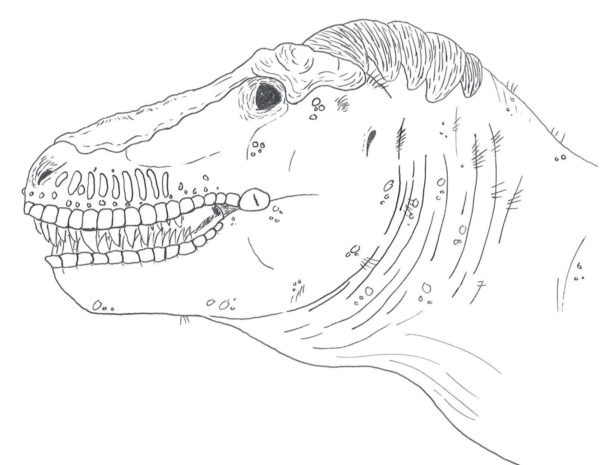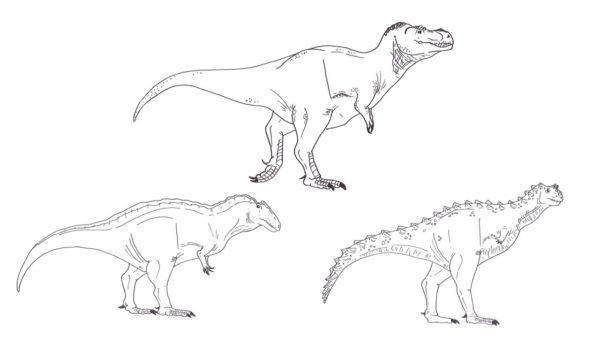
With nearly every movie star in the world, the fans usually only see the glamourous side, their true nature only glimpsed by the privileged few lucky enough to dwell within the insular world they occupy. Once we see the truth of our celebrities, it’s often disappointing, and leaves us disillusioned. I think this is how many people feel when confronted with the unglamorous facts about the world’s most famous dinosaur.
Tyrannosaurus rex has always had to struggle to live up to its own hype. The beast was named by American Museum of Natural History paleontologist Henry Fairfield Osborne (remember him from the Velociraptor article?) from material collected in Wyoming by Osborne’s right-hand-man, the legendary Barnum Brown. Osborne knew he had a prize on his hands- the largest carnivorous dinosaur known at the time- and Brown returned from further expeditions with a complete skull and even more fossils for display. Osborne was a born showman, and showcased his new dinosaur as the biggest, most powerful, and deadly predator to ever haunt the planet. This was back in the days when dinosaurs were regarded by both the public and scientists as little more than gaudy, primitive monsters to display in museum halls as prehistoric curiosities to draw in paying crowds so that paleontologists could work on more ‘serious’ topics. So from day one, Tyrannosaurus was perceived as a pop-culture monster first, despite our knowledge about it improving exponentially.
First things first- let’s start off with the name. To some people, this dinosaur has only ever been T. rex, and you’ll often see it spelled as ‘T. Rex’, ‘T-Rex’ or even ‘T-REX’. These variations of T. rex make it out like the dinosaur has some sort of special code-name, as if there’s also A-Rexes to Z-Rexes out there somewhere. I’ve spoken to kids and adults alike who have no idea what I’m talking about when I say ‘Tyrannosaurus’. So, to bring everyone onto the same page- all animals have 2-part or binomial scientific names. Ours is Homo sapiens. Outside of scientific literature, we usually refer to living animals by their common names, the ones we use casually for them. Almost no fossil animal has a common name, we refer to them by their scientific names, but usually only the first part (the genus). Triceratops, Stegosaurus, Brontosaurus– these are all genus names, and get italicized when written. Full scientific names can be abbreviated for convenience- Homo sapiens get shortened to H. sapiens. Brontosaurus excelsus is shortened to B. excelsus. So the T in T. rex is short for Tyrannosaurus.
As much as Tyrannosaurus is celebrated and feared in film and other media, these sources also seem to like punching up on the dinosaur at the same time. Everyone’s heard the allegations that Tyrannosaurus couldn’t see anything that wasn’t moving (which also seems to knock out its sense of smell), had weedy, pathetic little arms that are the butt of a thousand jokes, and respected paleontologists have accused it of being a cowardly scavenger that never hunted its own prey. It stomped around and bellowed like Godzilla, and had (gasp) feathers and was essentially a giant, silly chicken. Why do we love to bring Tyrannosaurus down a peg? Most of this isn’t even true, anyway.
The size of the eye sockets and the visual centers of the brain of Tyrannosaurus tell us it had extremely good sight, better than that of a hawk or eagle and far better than humans (Stevens, 2006). And their sense of smell was on par with that of turkey vultures, the bloodhounds of the bird world (Witmer & Ridgely, 2005). This means that the dinosaur could see and smell its prey long before the prey became aware of it. And a Tyrannosaurus attack was probably not as dramatic as seen in movies, with the creature roaring and stomping about before striking. What kind of predator announces that it’s there before attacking its prey? Lions don’t roar and gnash their teeth before striking at an antelope, and neither would Tyrannosaurus. And even if it wanted to stomp around and bellow its lungs out, it couldn’t anyway. With hollow bones and thick fleshy pads on the walking surfaces of its feet, Tyrannosaurus was lighter than it looked and well-cushioned to boot. Elephants have similar padding under their feet, and unless they’re trying to be noticed, you can’t really hear elephants when they walk. The acute senses and agile movement of this animal should hopefully demonstrate that Tyrannosaurus was certainly a capable hunter, able to bring down its own prey with the same success rates as modern carnivores. This is in contrast to the popular rumor that Tyrannosaurus was strictly a lazy scavenger. However, just like all large modern predators, Tyrannosaurus likely would not have turned its nose up at easy meat when it could get it, and probably subsisted off a balance of hunting and scavenging off of relatively fresh kills.

Possible life reconstruction of Tyrannosaurus, inspired by work of Dr. Mark Witton. Despite recent claims of crocodile-like skin on the head, many paleontologists still argue that tyrannosaurs had fleshy lips and scant tufts of feathers. Note the big, forward-facing eyes. Image by Nicholas Carter
One thing that always ruins everyone’s day is learning that Tyrannosaurus couldn’t roar (Senter, 2008). That’s a distinctly mammalian trait, with our sophisticated voice boxes and sound control. Look up the sound that big ground birds like ostriches, emus, and cassowaries make, if you don’t get out to the plains of Africa or Australia much. It’s not too different than the sounds produced by alligators and crocodiles- low-frequency booms, snarls, hisses, and growls. Data from the throat parts of predatory dinosaurs indicate that Tyrannosaurus was capable of these kinds of noises. And no, just because songbirds are little theropod dinosaurs doesn’t mean that T. rex was tweeting and chirping its way through the Cretaceous. The voices of songbirds are a highly specialized feature unique to only them.
The arms of Tyrannosaurs are the subject of so many tired jokes. Ever since the small front limbs of the closely related Gorgosaurus were discovered, people have wondered what tyrannosaurs were using their arms for. Were they for holding and slashing prey during predation attempts, grasping mates during reproduction, or some other use we haven’t thought of yet? In my opinion, I’d change the way in which we ponder the use of this feature. Front limbs in animals rarely, if ever, have only one single function. So why do we treat the front limbs of tyrannosaurs as tiny specializations for only one specific task? Theropods probably used their arms for all sorts of tasks, depending on the species or group- grasping prey, climbing trees or rocks, scratching themselves, reaching for branches, signaling with display feathers, fighting with one another, providing thrust for running up steep inclines, and gliding/flying. The list goes on. I would ask which of these tasks were the arms of Tyrannosaurus completely incapable of doing (most seem obvious, but hard data is important in science), and whatever wasn’t impossible remains, to some degree or other, possible. Given that tyrannosaurs had such drastically reduced front limbs I’d suspect they weren’t used for any one thing in particular, and probably served a few uses but just barely. Many large theropods of different lineages seemed to have gotten on just fine with barely functioning forelimbs- the giant Acrocanthosaurus could barely swing its small arms foreward (Senter et al. 2005), making them useless for grasping anything, and the nub-armed Abelisaurids of the southern hemisphere make Tyrannosaurus look like a weightlifter.

Think Tyrannosaurus is the only big predator with less than useful arms? Acrocanthosaurus and Carnotaurus beg to differ. Image by Nicholas Carter
Now, the whole feather thing… When former Philip J. Currie Dinosaur Museum palaeontologist Dr. Phil Bell and colleagues published a study in 2017 on known tyrannosaur skin impressions, the palaeo-world became a flurry of passions (Bell et al. 2017). Bell and colleagues checked out skin impressions from some of our best known late Cretaceous tyrants- Tyrannosaurus, Gorgosaurus, Albertosaurus, and Daspletosaurus from North America and Tarbosaurus from Asia. These skin impressions were from various points of the body, but none showed any evidence of feathers. Just standard dinosaurian scales. This was more than a little unexpected, seeing as how dinosaur families close to the tyrannosaurs have all shown evidence of feathers, and so have primitive tyrannosauroids like Dilong and Yutyrannus. Some might say that the giant late Cretaceous tyrants had no need of feathers, and so evolution did away with them. But the early Cretaceous Yutyrannus of China, which lived in fairly similar environments, rivals these later species in size, so why did it still have feathers? Bell and coauthors speculated that somewhere between the primitive tyrannosauroids to the advanced tyrannosaurids proper, feathers somehow became less desirable and these dinosaurs reverted back to mostly scaly skin. It might have something to do with gigantism in these later species, but we aren’t sure, and Yutyrannus throws a bit of a wrench into that idea. All this isn’t to say that Tyrannosaurus was completely featherless, though. We think of big mammals like elephants and rhinos as hairless, but have you ever taken a close look at these animals (safely)? They generally have thin remnants of bristly hair in certain patches of their body, barely noticeable unless you’re up close. I wouldn’t be surprised if Tyrannosaurus and its kin had something like that going on with their feathers.
It’s important to remember, with all the depictions of Tyrannosaurus showing it as a mindless, bloodthirsty monster, that it was first and foremost an animal. One that we’re still trying to understand, even though it’s perhaps the best-studied Mesozoic dinosaur. It would have spent most of its time doing typical boring animal activities, and like all modern carnivores it likely missed more kills than it made. Tyrannosaurus doesn’t care if we’re disappointed or elated at what science discovers about it. The animal was what it was, and the real Tyrannosaurus is good enough for me.
-By Nicholas Carter
References
Bell, P. R.; Campione, N. E.; Persons IV, W. S.; Currie, P. J.; Larson, P. L.; Tanke, D. H.; Bakker, R. T. (2017). “Tyrannosauroid integument reveals conflicting patterns of gigantism and feather evolution”. Biology Letters. 13 (6)
Senter, Phil; Robins, James H. (2005). “Range of motion in the forelimb of the theropod dinosaur Acrocanthosaurus atokensis, and implications for predatory behaviour”. Journal of Zoology. 266 (3): 307–318
Senter, P. (2008). “Voices of the past: a review of Paleozoic and Mesozoic animal sounds”. Historical Biology. 20 (4): 255–287
Stevens, Kent A. (June 2006). “Binocular vision in theropod dinosaurs”. Journal of Vertebrate Paleontology. 26 (2): 321–330
Witmer, Lawrence M.; Ridgely, Ryan C. (September 2009). “New Insights Into the Brain, Braincase, and Ear Region of Tyrannosaurs (Dinosauria, Theropoda), with Implications for Sensory Organization and Behavior”. The Anatomical Record. 292 (9): 1266–1296
